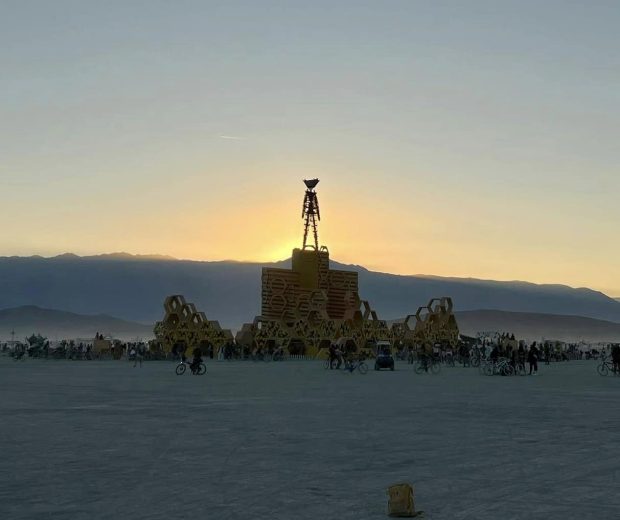My blog usually focuses on the topic of self protection and survival. This post detailing a recent experience is a little different. Stick with it, as there will be some survival lessons I hope you will find useful.
I first went to Burning Man back in 2013. Since then I’ve attended a total of six of the annual burns. I just got home from the most recent event.
Burning Man is almost impossible to describe to someone who hasn’t experienced it. The uninformed might call it an art and music festival. That really doesn’t even scratch the surface. Yes, there is a lot of art and a lot of music, but I think the event is better described as an “immersive experience.” It’s a playground for adults. You can encounter almost anything during the nine days the temporary city exists in the desert of northern Nevada.
Almost all the art is physically interactive and randomly spaced across an area about eight square miles in size. There are dozens of concerts/DJs/ music events happening 24 hours a day, but there are few set schedules. You either stumble across your favorite performer or you don’t. Burning Man thrives on serendipity and spontaneity.
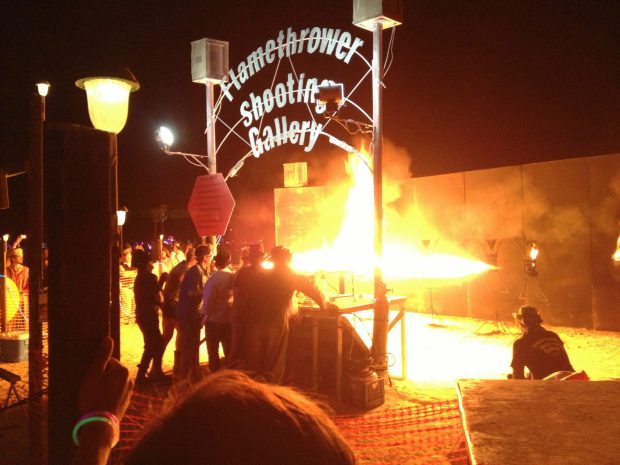
Upon entry, each participant is given a book (about 150 pages) of scheduled lectures, workshops, and group activities. Everyone can participate in as many or as few of the events as he/she desires. Nothing is off limits at Burning Man. People can attend workshops ranging across topics as practical as installing solar electricity systems, making jewelry, playing musical instruments, or healing psychological trauma.
The more adventurous folks can complete workshops in psychedelic breath work, rock climbing, navigating altered mental states, or even participatory Tantric sex orgies. A 50-mile ultra marathon race happens. You can play naked flag football or visit the temporary roller skating rink. People fight in a full scale reproduction of the Thunderdome from Mad Max. You can skydive or participate in a flame thrower shooting accuracy contest. Clothing is optional. Almost nothing is out of bounds at Burning Man.

I went to Burning Man with a friend. She had never attended before. This is the perpetual facial expression of someone experiencing the event for the first time.
Some of you will think that sounds cool. It is. But it isn’t easy. In fact, it’s quite a physical challenge.
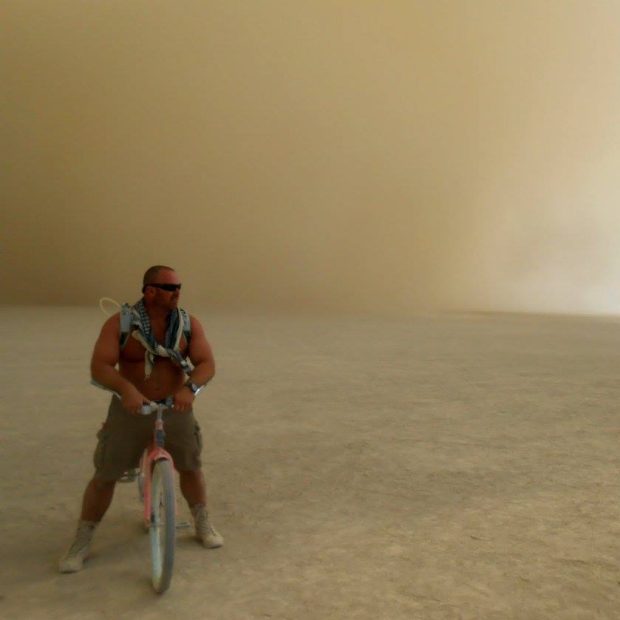
Burning Man dust storm
At Burning Man the only thing for sale is coffee and ice. There is no electricity, running water, internet, or cell service. The only physical facilities are portable toilets. There is no trash collection or food preparation areas. The nearest town is about 15 miles away and in/out traffic is strongly discouraged. Burning Man is the largest “Leave No Trace” camping event on the planet
The event is held on the “playa,” a flat desert environment with nearly constant dust storms. Temperatures are in the 90s during the day and 40s at night. The wind blows pretty constantly at 20-30 miles per hour. It is often so dusty that visibility is only about 10 feet. It’s a fun place, but just surviving in this environment is a tremendous physical challenge.
Each participant must bring his own food, water, and shelter for the the extent of the stay. Staff members evaluate each attendee upon entry to the event. If the staff deems that you don’t have adequate supplies to successfully survive, you will be turned away and refused access. Despite the tremendous adventures to be had at the event, merely existing in the environment is brutal and physically demanding.
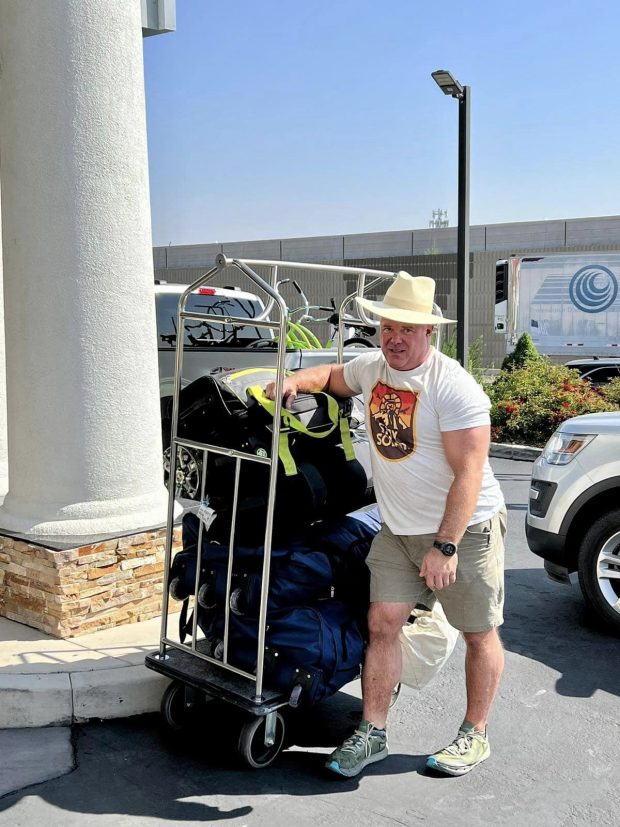
The amount of gear it takes to allow two people to thrive for a week in harsh desert conditions.
Veteran burner Michael Michaels provides an excellent event description:
“At Burning Man, we’ve found a way to break out of the box that confines us. What we do, literally, is take people’s reality and break it apart. Burning Man is a transformation engine- it has hardware and it has software, you can adjust it and tweak it. And we’ve done that. We take people out to this vast dry place, nowhere, very harsh conditions. It strips away their luggage, the things they’ve brought with them, of who they thought they were. And it puts them in a community setting where they have to connect with each other, in a place where anything is possible. In doing so, it breaks their old reality and helps them realize they can create their own.”
Burning man is a truly unique environment, the likes of which I have never seen anywhere else on the planet. More than 70,000 people attend each year. When the city is built and temporarily occupied, it is the third largest city in Nevada. What makes it work are its Ten Principles. Of the 10, I think three are primarily responsible for the event’s continual success.
Radical Inclusion– Everyone is welcome so long so they make a positive contribution to the group as a whole.
Radical Self-reliance– There are few freeloaders. You are expected to take care of yourself and will be thrown out if you can’t do so.
Gifting– Each person is expected to bring his/her own unique gifts (either physical, artistic, or intellectual) to enrich the experiences of the rest of the participants.
Now that we’ve established some of the basic detail about how the event works, let’s get into the survival challenges burners faced this year. Last Friday it rained almost an inch of water onto the hard-packed desert soil. Average rainfall there during the four months a year it occasionally rains is less the a half inch per month. It was unprecedented to get two months’ worth of rain in an 18-hour time period. The rain created massive desert floods and the hard desert soil turned into eight inches of slippery sticky mud.
The entrance and departure gates were closed for two days. No one could drive out through the horrific mud. Participants were essentially trapped in a huge flooded desert mud plain unless they were willing to trudge more than six miles on foot through the muck to get to the closest paved road. Things became a bit chaotic because people couldn’t physically leave their camp, the portable toilets couldn’t be serviced, and emergency police/medical services could not access the site.
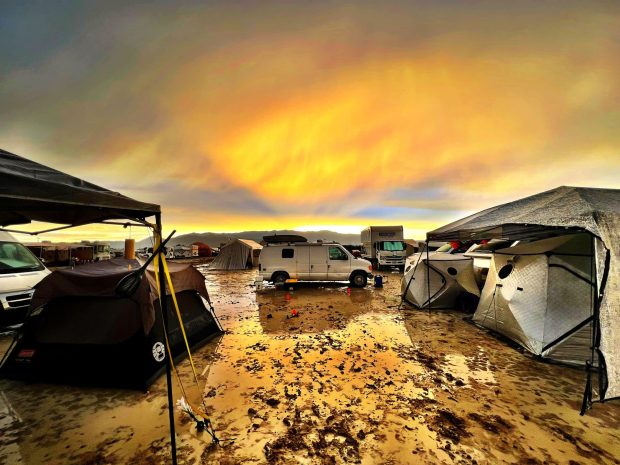
The mud and crazy sky during a brief respite from the pouring rain.
As is typical, the news media sensationalized the event. Reporters who couldn’t get to the site (the entrance was closed, remember?) reported utter chaos, masses of untreated hypothermia victims freezing in inadequate shelters, and people in drug induced hazes wallowing in human excrement. The media alluded to lawless uncontrolled riots, mass casualties, and the entire event being declared a biohazard quarantine zone. “Journalists” spread rumors of the national guard being mobilized to quell the rebellion. Utterly ridiculous.
I’m happy to report that Burning Man was nothing like what was reported in the media. I got out just fine and so did everyone else I camped with. Yes, it was unusually rainy and cold. No one could leave for a couple days because of muddy roads. But very few folks were planning on leaving on Friday or Saturday when the roads were too muddy to navigate. Almost everyone leaves on Sunday or Monday at the end of the event.
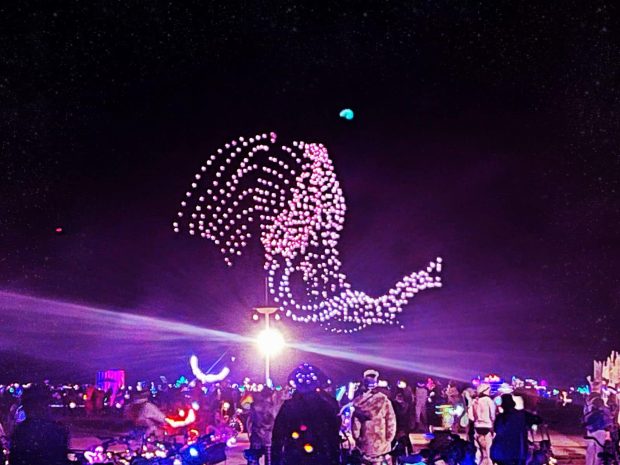
Illuminated drones in the sky
Burners were generally prepared for this calamity. They know there is nothing for sale. They know there is no electricity, no food, no running water, and no internet. Every single person going to the event brought their own food, water, and shelter expecting to stay for up to nine days.
It got really wet. It got super muddy. Nighttime temperature lows weren’t any colder than usual. Almost everyone was prepared for all that. Despite the garbage news reports, the cold and mud was a complete non-event for 98% of the people there.
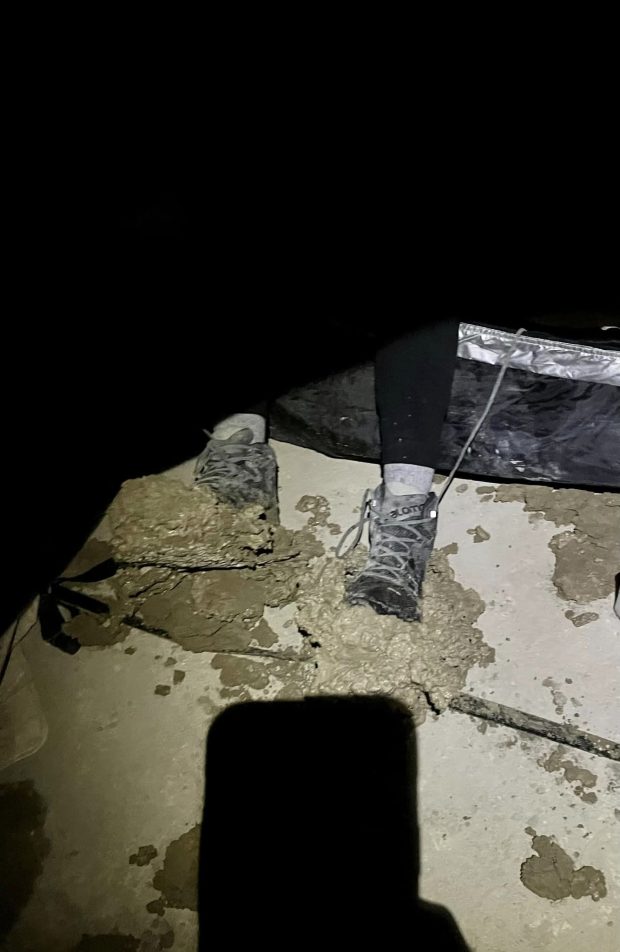
My friend’s muddy boots after her short walk to the portable toilets
If anyone can survive a deluge and chaotic camping conditions, I’d put my money on a burner. This quote sums things up admirably:
“Burners are exceptionally skilled at functioning during chaotic crises when normal services- running water, electricity, communication channels and sanitation systems- are not available. Burners don’t just survive in such an environment; they create culture, art, and community there.”
– Peter Hirshberg
The big man burn didn’t happen as scheduled because they couldn’t get fire trucks in on the muddy road. My camp constructed our own man out of scrap wood and got a neighboring camp’s art car to provide music as we held our own man burn party. About 250 random folks joined us for an incredibly enjoyable evening.
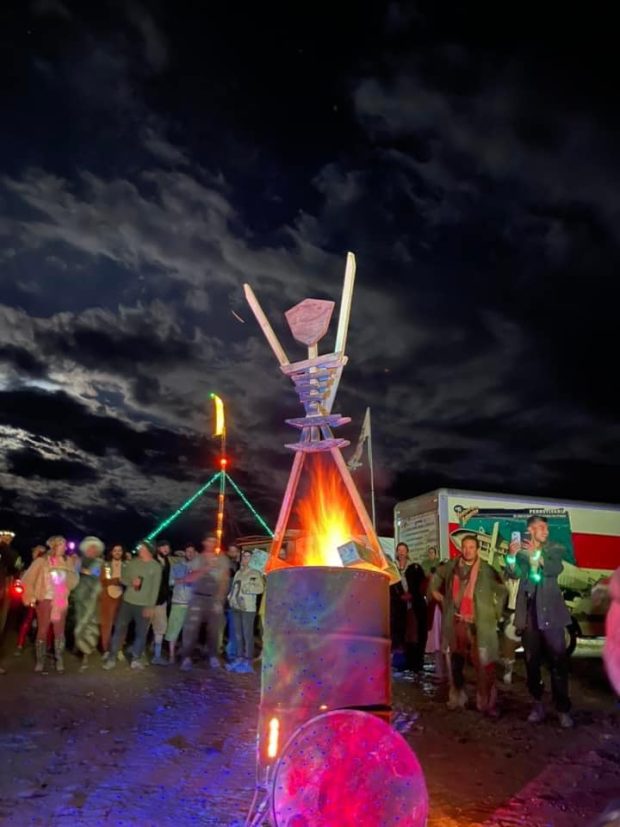
Rest assured, I was prepared to ascend the throne as king hippie barbarian warlord should the conditions have degenerated into a Lord of the Flies style event. That didn’t happen. Almost everyone had lots of fun and took good care of everyone else. Don’t believe the media hype. It was by far the easiest apocalypse I’ve ever experienced.
With that said, I did learn some lessons as I survived the flood, mud, and chaos. Read on as I share those lessons as well as the action plans I have implemented to mitigate such problems in the future.
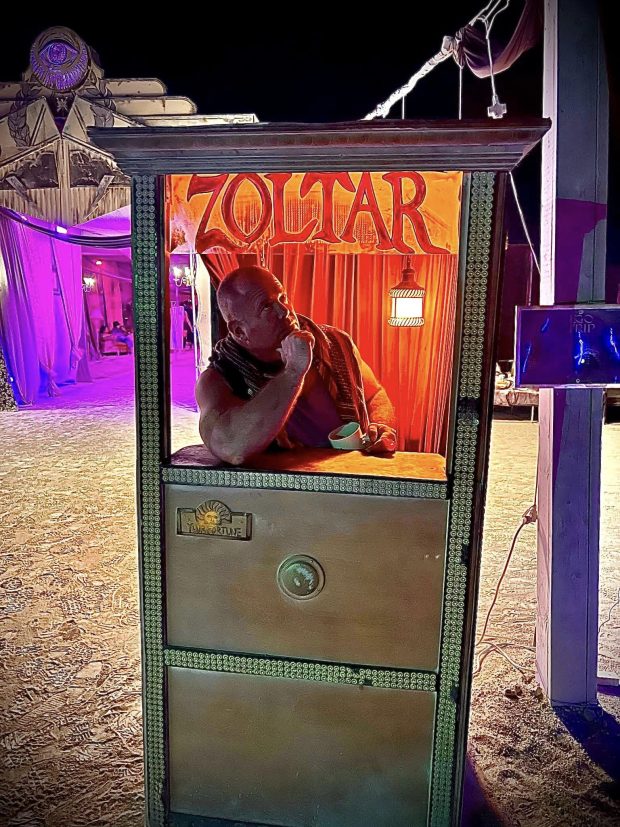
Fortunes told here
Medical preparations are critical. This is the element that had the most potential for disaster. There are a few medical professionals working at the event, but even on a good day the closest hospital is more than a two-hour lights and siren ground transport. During the flood, ambulances couldn’t access the playa. No helicopter was flying in the horrible rain and winds. Have you ever considered what you would do if you had a serious medical emergency in that kind of environment?
Even though civilization was relatively close, no one was coming to help us for a very long time. I had a 4×4 pickup truck as a rental. I mentally prepared an exfil plan in the event myself or one of my long time camp mates became seriously ill or was badly injured. I was glad I had packed my larger trauma kit with all the meds I carry when I travel to remote foreign countries. I had the skills and equipment to care for myself and friends in the absence of a traditionally functioning EMS system.
That gave me a tremendous amount of peace of mind. Fortunately, I didn’t have to use my equipment or skills. I’m going to redouble my efforts to continue learning how to diagnose and treat patients should I be put in another situation with an abnormally long medical response time. I’m going to carry my full medical kit with me on all my trips, even those when I don’t leave “civilization.” An event like this flood could happen almost anywhere and anytime.
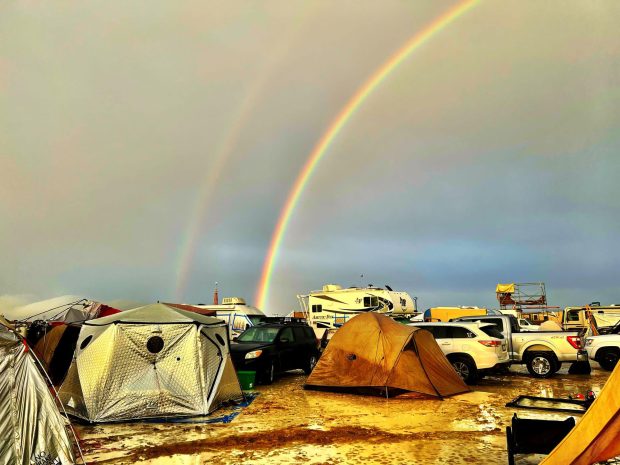
Double rainbow after the storm ended
Hypothermia is a thing. I was dressed for a hot desert environment. I had some warmer clothes packed, but when the rain started, I was having fun with my friends and decided I didn’t need them. I had no rain gear as I was camping in the desert. As the rain continued to pour down, I stubbornly refused to go back to my tent for warmer clothes. It was about 55 degrees with 30 mph wind gusts and constant rain. I was barefoot, wearing shorts and a cotton hoodie. Within a short time, I was thoroughly soaked. I stayed out in the rain having fun with all my camp mates as the temperature dropped. I was cold, but couldn’t be bothered to put on warm clothes.
By the time I got back to our tent and turned in for the evening, my body temperature had dropped significantly. I got out of my soaked clothing and crawled into bed. I was shivering and shaking the air mattress so badly that my friend couldn’t fall asleep. The uncontrollable shivering lasted almost 45 minutes. I knew that I would be fine because I was dry and in a warm sleeping bag, but I unnecessarily worried my companion because I was too stubborn to put on clothing more suitable for the cold and wet environment.
I had been in similar situations before doing cold weather camping as a Boy Scout. I wasn’t really worried because I had successfully navigated the beginning stages of hypothermia numerous times before. Despite that fact, I was surprised at how quickly my body temperature dropped in 50 degree weather. The rain and wind made what would have been a normally comfortable day in the 50s potentially dangerous. I’m going to start packing a lightweight wind/rain shell jacket on all my trips even if I don’t expect cold or wet weather.
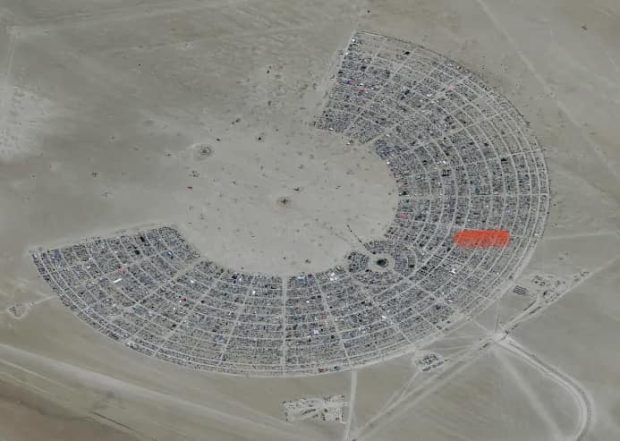
The camp layout. We camped near where the red mark is on the map.
From one side of the aerial photo to the other is about three miles in length. 80K people are staying here.
Waste Management was a challenge. One of the biggest issues was that the trucks couldn’t get through to service the portable toilets. By the time the roads dried out enough for the trucks to get back in, the toilets were getting really full and quite nasty. Do you have a plan to deal with solid waste in an environment like that when the toilets overflow? I hadn’t previously thought about that. I will in the future.
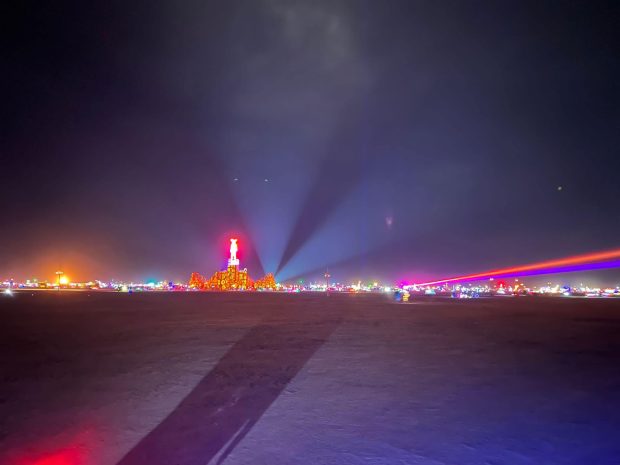
The “Man” lit up at night from about a mile away
Life skills are really important. As John Danaher says: “The path to excellence in all fields of life is skill acquisition.” He’s right.
The only people who had trouble during this disaster were the folks lacking basic survival life skills. Some folks didn’t know how to pitch a tent so that it stays dry in wet weather and stays upright in heavy winds. They suffered and had to endure the elements as their shelters collapsed on them. Some folks didn’t know how to cook food safely in the rain. They took the chance of burning their camps down by cooking inside tents. Fortunately my many years as a boy scout and wilderness survival instructor gave me the knowledge to deal with such problems and stay generally comfortable in the elements.
Beyond camping life skills, I saw lots of folks unable to repair their bicycles in the inclement weather. Other folks got their vehicles stuck because they didn’t know how to drive through the slippery mud. A misspent youth spent mud running in beater pickup trucks and driving a rear wheel drive Crown Victoria police cruiser through snowy Ohio winters gave me the skills to successfully traverse the mud as soon as it was reasonably safe to do so.
I’m going to continue to try to increase my skill sets across broad domains and activities. Having general life skills really helped me avoid becoming a hazard or a victim.
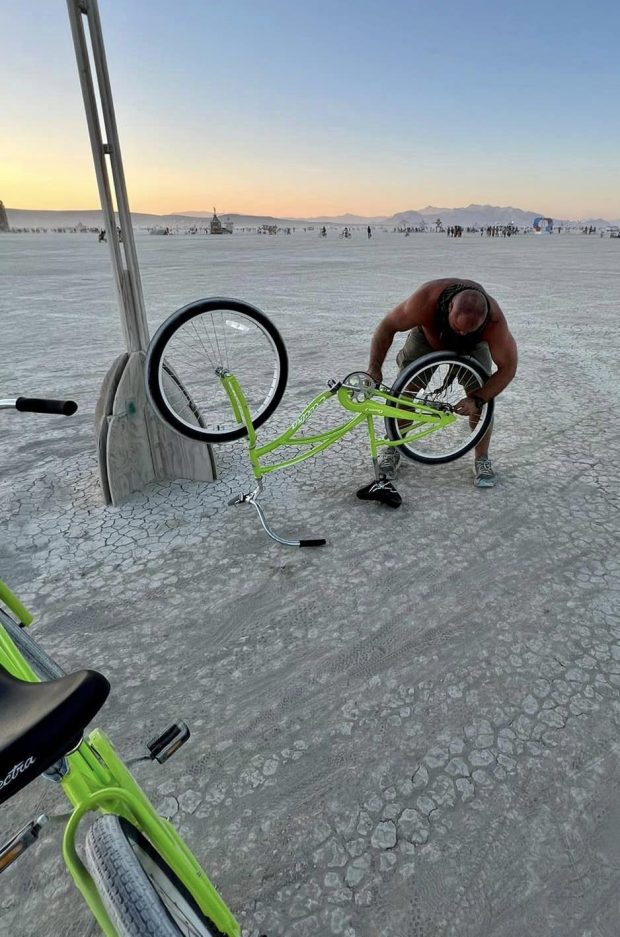
Fixing a broken bicycle before the rains started
Community is everything- Part of the reason there were fewer issues than we could have seen is the intense level of community Burning Man builds. I had about 20 people in my camp. I met most of them on my first trip to the playa more than 10 years ago. We all had different skill sets and resources. We were all committed to minimizing the suffering of everyone in our camp. We fortunately had enough resources to help others who weren’t as well prepared.
I know lots of you have the plan on being a “lone wolf” in any survival situation. In my experience, those folks don’t do as well as other people who have a strong community support network. In this crisis, none of my friends had to worry. The group would take care of its own no matter what. That gave us all the luxury of not worrying about ourselves. We could then “gift” our skills and resources to those less prepared.
That was a good feeling. I’m going to work on building more community in the “default world” as well. I would suggest that you do the same.
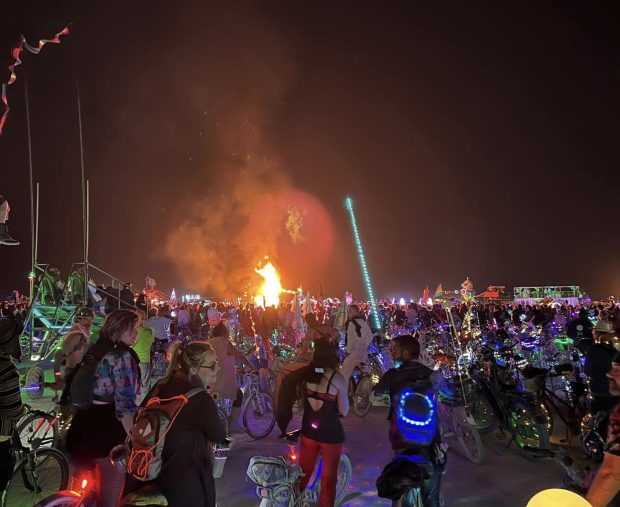
The playa at night with burning art
Burning Man isn’t for everyone. For me it serves as an excellent mental “reset.” It’s nice being part of an intentional community who can help others in trouble. It’s fun to re-experience childlike wonder in an adult playground. The event creates great emotional bonds and lets me experience all the good aspects of humanity that are so sadly lacking in our everyday existences. Despite the challenges, I’ve been irrationally happy since my return. I’ll definitely be going back. If you are interested in attending the event for yourself next year and have any questions, please contact me. I’m happy to help out however I can.
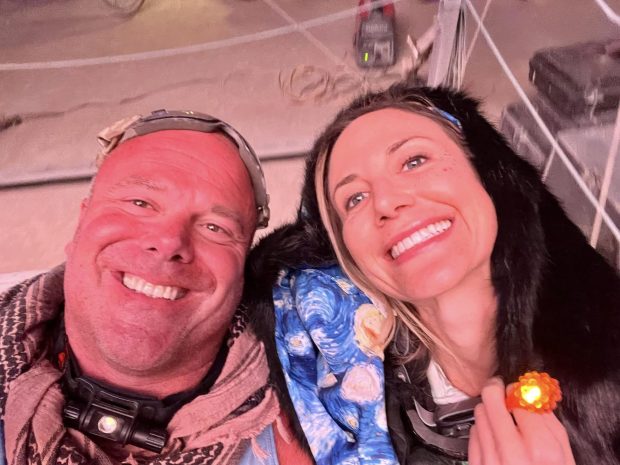
Enjoying an event the media called an “apocalypse.”

